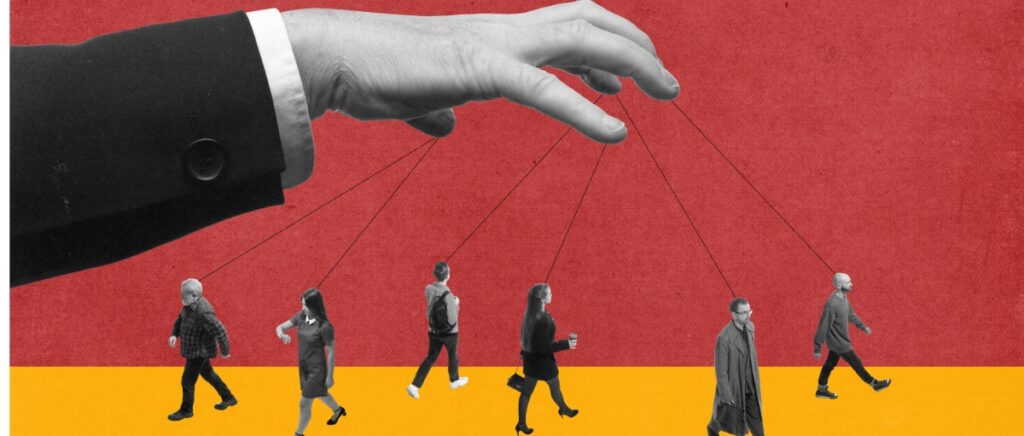Is there someone in your life who always seems to be telling you what to do? Maybe it’s a spouse who constantly criticizes your choices, a friend who guilt-trips you into doing things their way, or a boss who micromanages your every move. If this sounds all too familiar, you may be dealing with a controlling person.
You’re not alone.
Controlling behavior is one of the most common forms of emotional abuse. According to data from the domestic violence hotline, 95% of their contacts reported experiencing emotional abuse. Emotional abuse may not be what most people think of when they picture abuse, but that does not make it any less real or serious.
Dealing with a controlling person can be frustrating, demoralizing, and downright exhausting. You may feel like you’re constantly walking on eggshells to avoid setting them off. Over time, you may start to doubt yourself and your judgment.
But you don’t have to live under someone else’s thumb forever. You can take concrete steps to set boundaries, communicate assertively, and ultimately reclaim control of your life and well-being.
What is Controlling Behavior?
At its core, controlling behavior is about power–one person’s desire to exert influence over another’s choices, actions, and even thoughts. A controlling person believes they know what’s best and will try to impose their will on others through various manipulative tactics.
Controlling behaviors can take many forms, but some common signs include:
- Frequently criticizing or second-guessing your decisions.
- Telling you what to do, what to wear, or who to spend time with.
- Isolating you from friends and family or discouraging you from activities you enjoy.
- Monitoring your communications, finances, location, or other personal information.
- Displaying excessive jealousy or suspicion of your interactions with others.
- Using guilt trips, shaming, or gaslighting to undermine your sense of reality.
- Invading your privacy or ignoring your requests for alone time or space.
These behaviors often stem from deep-seated insecurity and a need to feel “in control.” But whatever the underlying reason, it’s important to recognize that attempting to dictate another adult’s choices is never acceptable – even when framed as “just trying to help.”
A Spectrum of Control
That said, not all controlling behavior is the same. Like many unhealthy relationship patterns, controlling behavior exists on a spectrum. On the milder end, it may look like a bossy coworker who always thinks their way is best or an overprotective parent who constantly hovers and frets over your choices.
While these behaviors are frustrating, they’re not necessarily abusive. But when left unchecked, even low-level control issues can escalate into more serious forms of emotional abuse and manipulation. And in some cases, controlling behavior can veer into outright intimidation, threats, and even physical violence.
The key is to trust your gut. If someone’s behavior consistently makes you feel guilty, small, powerless, or afraid, it’s crossed the line from mere annoyance to genuine toxicity. You deserve to have your autonomy respected in all your relationships. We’ll discuss some strategies for setting boundaries and standing up to a controller.
Why Do People Become Controlling?
We’ve all encountered a control freak or two in our lives. But have you ever wondered what makes someone feel the need to dictate others’ every move? As frustrating as controlling behavior can be, understanding its reasons is an important step in learning to cope with the controllers in your life.
Controlling Behavior as a Coping Mechanism
In most cases, an excessive need for control is actually a mask for deep-seated insecurity and fear. At their core, controlling people are often plagued by doubts about their own worth and competence. They may have low self-esteem or an intense fear of abandonment rooted in early experiences of instability or trauma.
For these individuals, micromanaging others’ behavior is a misguided attempt to quell their own anxieties. Much like a child who clings to a security blanket, they latch onto control as a way to feel safe in an unpredictable world. By always being the one to call the shots, they can avoid the discomfort of confronting their own uncertainties.
In other cases, a person’s controlling nature may reflect the dynamic they grew up with. If they had an overbearing or hypercritical parent, they may have internalized the message that maintaining ironclad control is the only route to success and love. Now, as adults, they perpetuate the same pattern by trying to mold their loved ones to an arbitrary standard of perfection.
When Control Issues Become Pathological
While a degree of control-seeking is present in many personality types, in some cases, it can cross the line into diagnosable mental health conditions. Personality disorders like narcissistic personality disorder (NPD) and obsessive-compulsive personality disorder (OCPD) are often characterized by a rigid need for control. In fact, OCPD is one of the most prevalent personality disorders in the general population, with an estimated presence ranging from 1.9% to 7.8%.
Individuals with these disorders tend to have an exaggerated sense of self-importance and a belief that their way is the only “right” way. They may exploit or demean others to maintain a position of authority. And they are often incapable of acknowledging other people’s needs or admitting when they’re wrong.
Needless to say, untreated personality disorders can wreak havoc on relationships. If you suspect your controlling loved one’s behavior might be a sign of a deeper pathology, urge them to seek professional help. With therapy and ongoing support, it’s possible to develop healthier ways of relating. Clients often report that the benefits of therapy treatment not only persist but also continue to improve after completion.
But remember, you can’t diagnose someone else or force them to change. Ultimately, your responsibility is to advocate for your own well-being. Even if you understand why someone is controlling, it doesn’t mean you have to tolerate being treated poorly. In the next section, we’ll explore some strategies for dealing with controllers firmly and compassionately.
Dealing with the Controllers in Your Life
By now, you have a clearer picture of what controlling behavior involves and where it comes from. But how do you actually handle the controller in your life? Here are some strategies to try.
Communicate Your Needs Clearly
Start by having an honest, non-blaming conversation with the controlling person about how their behavior affects you. Use “I”-statements to keep the focus on your own experience and emotional needs.
For example, instead of saying, “You’re always telling me what to do,” try, “I feel frustrated when my decisions are questioned. I need to feel trusted to handle things my own way.”
Remember, you can’t argue someone out of their insecurities. But you can kindly express how their attempts to control you damage the relationship.
Set (and Enforce) Firm Boundaries
Controllers often struggle to respect others’ limits. That’s why it’s crucial to get crystal-clear on what you will and won’t tolerate and communicate those boundaries unequivocally.
For instance, you might say, “I appreciate your concern, but I’m not looking for advice right now. If I need help, I’ll be sure to ask.” Or, “I need to be able to spend time with friends without always checking in. Let’s agree on some basic ground rules for independence.”
Then, follow through with consequences if your boundaries keep getting trampled. That might mean hanging up the phone, walking away from a conversation, or limiting contact for a while. Boundaries aren’t really boundaries unless they have teeth.
Take Care of Yourself First
It’s easy to get so caught up in managing a controller’s reactions that you forget to prioritize your own needs. But self-care isn’t selfish. In fact, it’s an essential part of reclaiming your autonomy.
Make time for activities that make you feel grounded and replenished. Maintain your other relationships to offset the controller’s influence. Consider working with a therapist to shore up your self-worth and assertiveness.
Remember, you can’t pour from an empty cup. The more you invest in your own resilience, the better equipped you’ll be to stand firm in your truth.
When Controlling Turns to Abuse
Sometimes, controlling behavior escalates beyond mere pushiness into outright abuse. If you’re experiencing any of the following warning signs from a controlling partner or family member, it’s time to seek help:
- Isolating you from friends and family.
- Monitoring your communications or whereabouts.
- Restricting your access to money or transportation.
- Calling you names, belittling you, or humiliating you in front of others.
- Threatening or intimidating you, punching walls, or breaking objects.
- Physically restraining you or blocking you from leaving.
- Pressuring or forcing you into unwanted sexual activity.
These behaviors are hallmarks of domestic abuse – and they’re never acceptable, no matter how much the abuser tries to downplay or justify them.
If you recognize your situation in this list, please know that you’re not alone and don’t deserve to be treated this way. Reach out to a trusted loved one, a domestic violence hotline, or even 911 if you’re in immediate danger. You can also look into local women’s shelters and support groups.
Making a safety plan is crucial if you need to leave an abusive situation. Collect important documents, memorize important phone numbers, and keep a packed bag and spare set of car keys at a friend’s house. Having a plan in place can help you leave quickly and safely when the time comes.
Healing from an abusive relationship takes time. Be gentle with yourself as you process the complicated emotions of grief, anger, and self-doubt. Seeking counseling can be immensely helpful as you rebuild your sense of self and learn to trust again. The road may be long, but peace and freedom are possible.
Reclaiming Your Power
If you’ve been tangled up with a controlling partner, you know how disorienting and demoralizing it can feel to have your every move scrutinized and judged. Every year, around 4 million older Americans suffer from physical abuse, psychological abuse, and neglect.
But here’s the good news: no matter how long you’ve been living under someone else’s thumb, it’s never too late to reclaim your autonomy. You have the right to make choices, be imperfect, and change your mind. No one else gets to dictate your life for you.
As you start to confront the controller in your life, remember to have compassion for yourself. Setting boundaries and speaking your truth takes immense courage when you’ve been conditioned to defer and accommodate.
Be patient as you flex your assertiveness muscles. Surround yourself with people who support and affirm your independence. And never forget, you are so much stronger than the controller wants you to believe.
With practice, support, and self-love, you can break free from the chains of control and step fully into the driver’s seat of your own beautiful journey!
Sources
National Domestic Violence Hotline. (n.d.). What is emotional abuse? National Domestic Violence Hotline. https://www.thehotline.org/resources/what-is-emotional-abuse/
National Domestic Violence Hotline. (n.d.). National Domestic Violence Hotline home page. National Domestic Violence Hotline. https://www.thehotline.org/
Psychiatry Online. (2022). Title of the article. Psychiatry Online. https://psychiatryonline.org/doi/10.1176/appi.focus.20220058
American Psychological Association. (2012). Resolution on psychotherapy. APA. https://www.apa.org/about/policy/resolution-psychotherapy
Domestic Violence Center of Chester County. (n.d.). Fast facts and statistics. DVCCC. https://dvcccpa.org/fast-facts-statistics/.











